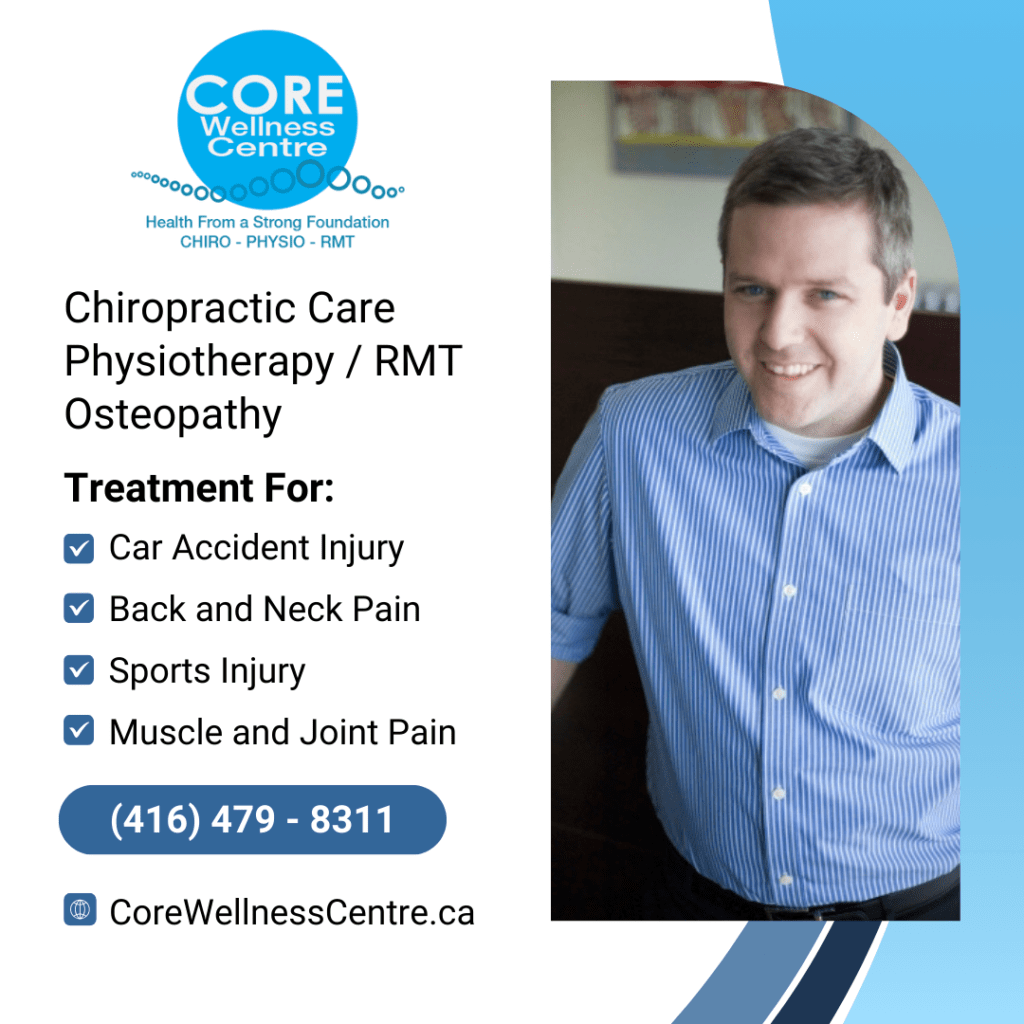
Have you ever been in a minor car accident and thought, “I feel fine, I’ll just walk it off”? Our comprehensive guide to whiplash treatment and recovery explains why this common reaction could lead to long-term problems.
While you might feel okay immediately after an accident, whiplash symptoms often develop gradually over 24-72 hours. Understanding what to look for and when to seek professional help can make a significant difference in your recovery journey.
If you’ve just been in a fender bender or had a rough tumble during a hockey game and have neck pain. At first it feels fine, but a day or two later, your neck feels stiff, sore and harder to move.
This could be more than just regular soreness – it could be whiplash.
Whiplash is a common neck injury that occurs when your head is suddenly jerked back and forth, straining the delicate structures in your neck. It’s one of the most frequent injuries from car accidents, sports collisions and even slips and falls.
Understanding Whiplash
Whiplash affects approximately 200,000 Canadians annually, occurring not just in vehicle accidents but also during:
- Sports impacts (such as hockey, football, gymnastics, martial arts)
- Slip and fall incidents, slipping unexpectedly
- Cycling accidents, falling off a bike
- Amusement park rides with sudden jerks or drops
- Workplace accidents
- Recreational activities
- Any quick, forceful movement of the head
The impact of whiplash can range from mild discomfort to chronic conditions affecting daily life. Early recognition and proper whiplash treatment are crucial for optimal recovery outcomes. Important: Even low-speed impacts (10-15 km/h) can cause significant injury.
Structure of the Neck Area
Your Neck is a delicate powerhouse. Think of your neck as a finely tuned system, like a suspension bridge connecting your head to your shoulders.
It’s made up of:
- Seven small bones (called cervical vertebrae) stacked like building blocks
- Discs between those bones that act like cushions or shock absorbers
- Muscles that support movement and hold your head upright
- Ligaments that stabilize the bones and keep everything in place
- Nerves that send messages between your brain and the rest of your body
When everything is working well, your neck moves freely and
supports your head without issue.
If you’re dealing with neck pain or stiffness, our team of experts are here to help you recover and restore your mobility.
WSIB Claims are welcome at Core Wellness Centre CALL (416) 479 – 8311 TODAY
or simply sign up below to see how we can help you.
What Happens During Whiplash

Whiplash occurs when your head is forcefully whipped back and forth in a fast, jerky motion – much like the snap of a whip. This typically happens during sudden impacts, like car accidents or falls. The motion begins with your head snapping backward, a movement called hyperextension, and is immediately followed by your head snapping forward, known as hyperflexion.
What makes this motion so harmful is how quickly it occurs – in just a fraction of a second. This speed is faster than your neck muscles can respond, leaving them unable to protect you. The result is that the forces involved push your neck well beyond its normal range of motion, putting significant stress on the tissues and structures inside.
Where Damage Can Happen
The violent movement during whiplash can cause strain
or injury to multiple parts of your neck.
For example, muscles may be overstretched or even torn, leading to soreness or stiffness. Ligaments, which are like supportive bands holding everything together, can be strained or, in severe cases, ruptured.
The discs that act as cushions between your neck bones might bulge or herniate, which can add pressure to nearby nerves. Speaking of nerves, the sudden jolt can compress or irritate them, potentially causing symptoms like pain, numbness, or tingling.
Finally, even the vertebrae themselves – the small bones of your neck – may shift out of alignment, further contributing to discomfort and mobility issues.
The Critical Time Window of Whiplash

One of the most important things to know about whiplash
is that symptoms don’t always show up right away.
After the initial injury, you may feel fine for a while, but this doesn’t mean no damage has occurred. In fact, symptoms like pain, stiffness, headaches, or dizziness often develop within 24 to 72 hours after the event.
This delayed onset of symptoms can lead to delayed treatment, which may make whiplash recovery more difficult or prolong your discomfort.
Many people dismiss their lack of immediate pain as a sign they’re uninjured, only to experience increasing symptoms days later.
That’s why early evaluation is so important,
even if you feel okay right after the incident.
A professional assessment can identify hidden injuries, start treatment early, and prevent the condition from worsening. Taking action sooner rather than later can significantly improve your recovery and help you avoid long-term complications.
Whiplash Treatment Options for Recovery

At Core Wellness Centre in Toronto, we offer a multi-discipline approach with chiropractic care, physiotherapy, osteopathy and RMT to support your recovery.
Ask us about Direct Billing and how we facilitate the process.
On-site x-rays if required.
When it comes to treating whiplash, a comprehensive approach is key to relieving pain, restoring mobility and preventing long-term issues.
Chiropractic Care Whiplash Treatment
Chiropractic care is highly effective in addressing whiplash by targeting the spine’s alignment and mobility. When your neck experiences the sudden forces of a whiplash injury, your spine can become misaligned, leading to added stress on the surrounding muscles, ligaments and nerves.
Chiropractor Dr. Kris, uses gentle spinal adjustments to correct misalignments caused by the whiplash injury. This reduces tension, improves the function of your neck and helps relieve pain. With careful, precise adjustments, chiropractic care can help improve your range of motion, allowing your neck to move more naturally and without discomfort.
Physiotherapy Whiplash Treatment Supports Recovery
Physiotherapy focuses on strengthening the neck and restoring the overall function of your muscles and joints. Our professional physiotherapist can create a personalized plan tailored to your specific needs.
Personalized Exercise Plans
Whiplash often leaves neck muscles weakened or stiff. Physiotherapy incorporates targeted exercises to rebuild strength, improve flexibility, and support recovery.
Soft Tissue Therapy
To ease pain and stiffness, physiotherapists use techniques like manual therapy to release tension and improve circulation in the affected areas.
Advanced Techniques
Tools like cold laser therapy (LLLT) and shockwave therapy can be incorporated to enhance recovery.
Other Whiplash Treatment Therapy at Core Wellness Centre
In addition to chiropractic care and physiotherapy, other therapies can provide valuable support to relieve pain and promote relaxation:
RMT Massage Therapy can help loosen tight muscles, ease pain, and improve circulation, all of which contribute to faster healing and better comfort.
Toronto Osteopathy helps treat whiplash by focusing on restoring balance and function to the body through gentle, hands-on techniques.
Osteopathy uses methods like soft tissue massage, joint mobilization, and cranial osteopathy to relieve tension, reduce pain, and improve mobility in the neck and surrounding areas. Our holistic approach not only addresses the injury but also promotes the body’s natural ability to heal itself.
By combining these therapies, you can address every aspect of a whiplash injury, from reducing immediate pain to strengthening your neck for the long term.
Seeking professional care early on is the best way to ensure a full recovery and avoid chronic neck issues in the future.
If you’re dealing with neck pain or stiffness, our team of experts are here to help you recover and restore your mobility.
WSIB Claims are welcome at Core Wellness Centre CALL (416) 479 – 8311 TODAY
or simply sign up below to see how we can help you.

